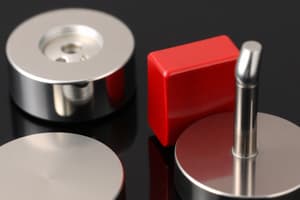Podcast
Questions and Answers
What force causes a rolling ball to eventually stop?
What force causes a rolling ball to eventually stop?
Friction
Why would it be impossible to walk without friction?
Why would it be impossible to walk without friction?
We would slip
Besides starting motion, what are two other effects of applying a force on an object?
Besides starting motion, what are two other effects of applying a force on an object?
Changing speed/direction, changing shape/size.
How does a magnet help keep a refrigerator door shut?
How does a magnet help keep a refrigerator door shut?
What is the key difference between a regular magnet and an electromagnet?
What is the key difference between a regular magnet and an electromagnet?
What is the historical origin of the term 'magnet'?
What is the historical origin of the term 'magnet'?
Besides iron, list two other materials that are attracted to a magnet.
Besides iron, list two other materials that are attracted to a magnet.
Explain the difference between magnetic and non-magnetic materials.
Explain the difference between magnetic and non-magnetic materials.
Where is the magnetic force of a magnet most powerful?
Where is the magnetic force of a magnet most powerful?
Describe the interaction between like poles of two magnets.
Describe the interaction between like poles of two magnets.
Define the concept of 'force' as it relates to magnets.
Define the concept of 'force' as it relates to magnets.
Explain how a magnet can attract a steel object, even though steel is not a 'magnetic element'.
Explain how a magnet can attract a steel object, even though steel is not a 'magnetic element'.
Provide an example of a force, besides magnetic force that is described in the text.
Provide an example of a force, besides magnetic force that is described in the text.
Flashcards
What is a magnet?
What is a magnet?
A substance that can attract certain materials, such as iron, nickel, and cobalt.
Types of magnets
Types of magnets
Natural magnets are found in nature, while man-made magnets are created by humans from materials like iron or steel.
Poles of a magnet
Poles of a magnet
The strongest force of a magnet is at its ends, called poles. Each magnet has two poles - a North Pole and a South Pole.
Magnetic materials
Magnetic materials
Signup and view all the flashcards
Non-magnetic materials
Non-magnetic materials
Signup and view all the flashcards
Like poles repel
Like poles repel
Signup and view all the flashcards
Unlike poles attract
Unlike poles attract
Signup and view all the flashcards
Forces and Friction
Forces and Friction
Signup and view all the flashcards
Friction
Friction
Signup and view all the flashcards
Force
Force
Signup and view all the flashcards
Newton's First Law of Motion
Newton's First Law of Motion
Signup and view all the flashcards
Electromagnet
Electromagnet
Signup and view all the flashcards
Magnets in Audio Devices
Magnets in Audio Devices
Signup and view all the flashcards
Study Notes
Magnets
- Magnets are special stones that interact with some metals.
- Natural magnets, like magnetite (lodestone), attract iron.
- Man-made magnets are usually iron or steel and come in various shapes (U-shaped, horseshoe, bar, rod, ring, button).
- Magnets attract some materials (magnetic materials) such as iron, nickel, cobalt, and steel.
- Non-magnetic materials are not attracted to magnets, including gold, silver, aluminum, copper, wood, paper, plastic, glass, and clay.
- Objects like nails and paperclips are magnetic because they are made of iron.
- Steel is also a magnetic material.
Magnet Characteristics
- A magnet's force is strongest at its poles (North and South).
- Like poles (N-N or S-S) repel each other.
- Unlike poles (N-S) attract each other.
- The north pole of one magnet attracts the south pole of another.
Force and Effects
- Force is a push or pull applied to an object.
- Forces can cause objects to start moving, change speed or direction, change shape, or stop moving.
- Examples of force include pushing a car, pulling a trolley, squeezing a lemon, kicking a ball, etc.
- Friction is a force that slows or stops a moving object.
Magnet Uses
- Magnets are used in many electrical appliances (telephones, headphones, speakers).
- Small electromagnets are used in computers and video recorders for handling information.
- Magnets can keep refrigerator doors shut.
Electromagnets
- Electromagnets are temporary magnets.
- They work as magnets when electricity flows through them.
Studying That Suits You
Use AI to generate personalized quizzes and flashcards to suit your learning preferences.





